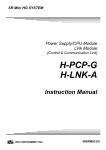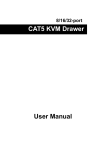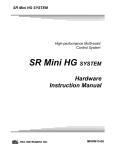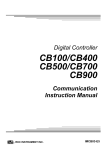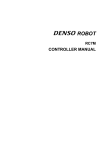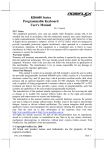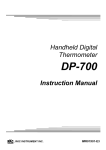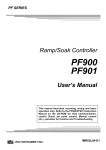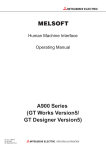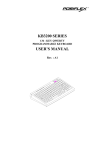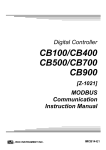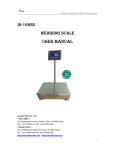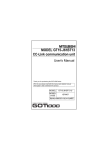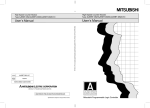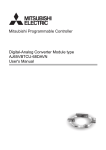Download H-PCP-G/ H-LNK-A Instruction Manual
Transcript
SR Mini HG SYSTEM Power Supply/CPU Module Link Module [Control & Communication Link] H-PCP-G H-LNK-A Instruction Manual ® RKC INSTRUMENT INC. IMSRM52-E4 The MELSEC and Control & Communication Link system are products manufactured by Mitsubishi Electric Co., Ltd. Company names and product names used in this manual are the trademarks or registered trademarks of the respective companies. . All Rights Reserved, Copyright 1998, RKC INSTRUMENT INC. Thank you for purchasing the RKC instrument. In order to achieve maximum performance and ensure proper operation of your new instrument, carefully read all the instructions in this manual. Please place this manual in a convenient location for easy reference. SYMBOLS WARNING : This mark indicates precautions that must be taken if there is danger of electric shock, fire, etc., which could result in loss of life or injury. CAUTION ! : This mark indicates that if these precautions and operating procedures are not taken, damage to the instrument may result. : This mark indicates that all precautions should be taken for safe usage. : This mark indicates important information on installation, handling and operating procedures. : This mark indicates supplemental information on installation, handling and operating procedures. : This mark indicates where additional information may be located. ! WARNING An external protection device must be installed if failure of this instrument could result in damage to the instrument, equipment or injury to personnel. All wiring must be completed before power is turned on to prevent electric shock, fire or damage to instrument and equipment. This instrument must be used in accordance with the specifications to prevent fire or damage to instrument and equipment. This instrument is not intended for use in locations subject to flammable or explosive gases. Do not touch high-voltage connections such as power supply terminals, etc. to avoid electric shock. RKC is not responsible if this instrument is repaired, modified or disassembled by other than factory-approved personnel. Malfunction can occur and warranty is void under these conditions. IMSRM52-E4 i-1 CAUTION This is a Class A instrument. In a domestic environment, this instrument may cause radio interference, in which case the user may be required to take adequate measures. This instrument is protected from electric shock by reinforced insulation. Provide reinforced insulation between the wire for the input signal and the wires for instrument power supply, source of power and loads. Be sure to provide an appropriate surge control circuit respectively for the following: - If input/output or signal lines within the building are longer than 30 meters. - If input/output or signal lines leave the building, regardless the length. This instrument is designed for installation in an enclosed instrumentation panel. All high-voltage connections such as power supply terminals must be enclosed in the instrumentation panel to avoid electric shock by operating personnel. All precautions described in this manual should be taken to avoid damage to the instrument or equipment. All wiring must be in accordance with local codes and regulations. All wiring must be completed before power is turned on to prevent electric shock, instrument failure, or incorrect action. The power must be turned off before repairing work for input break and output failure including replacement of sensor, contactor or SSR, and all wiring must be completed before power is turned on again. To prevent instrument damage or failure, protect the power line and the input/output lines from high currents with a protection device such as fuse, circuit breaker, etc. Prevent metal fragments or lead wire scraps from falling inside instrument case to avoid electric shock, fire or malfunction. Tighten each terminal screw to the specified torque found in the manual to avoid electric shock, fire or malfunction. For proper operation of this instrument, provide adequate ventilation for heat dispensation. Do not connect wires to unused terminals as this will interfere with proper operation of the instrument. Turn off the power supply before cleaning the instrument. Do not use a volatile solvent such as paint thinner to clean the instrument. Deformation or discoloration will occur. Use a soft, dry cloth to remove stains from the instrument. To avoid damage to instrument display, do not rub with an abrasive material or push front panel with a hard object. Do not connect modular connectors to telephone line. NOTICE This manual assumes that the reader has a fundamental knowledge of the principles of electricity, process control, computer technology and communications. The figures, diagrams and numeric values used in this manual are only for purpose of illustration. RKC is not responsible for any damage or injury that is caused as a result of using this instrument, instrument failure or indirect damage. RKC is not responsible for any damage and/or injury resulting from the use of instruments made by imitating this instrument. Periodic maintenance is required for safe and proper operation of this instrument. Some components have a limited service life, or characteristics that change over time. Every effort has been made to ensure accuracy of all information contained herein. RKC makes no warranty expressed or implied, with respect to the accuracy of the information. The information in this manual is subject to change without prior notice. No portion of this document may be reprinted, modified, copied, transmitted, digitized, stored, processed or retrieved through any mechanical, electronic, optical or other means without prior written approval from RKC. i-2 IMSRM52-E4 CONTENTS Page 1. OUTLINE............................................................................... 1 1.1 Product Outline................................................................................................1 1.2 Handling Procedure.........................................................................................2 1.3 Checking the Products ....................................................................................3 1.4 Confirmation of the Model Code ......................................................................4 1.5 System Configuration ......................................................................................5 1.6 Parts Description .............................................................................................7 1.6.1 H-PCP-G module ................................................................................................. 7 1.6.2 H-LNK-A module .................................................................................................. 8 2. SPECIFICATIONS .............................................................. 10 2.1 H-PCP-G Module...........................................................................................10 2.2 H-LNK-A Module ...........................................................................................13 3. MOUNTING ......................................................................... 15 3.1 Mounting Environment...................................................................................15 3.2 Dimensions....................................................................................................16 3.3 Mounting the Mother Block ............................................................................18 3.4 Mounting the Module .....................................................................................20 3.5 Removing the Module....................................................................................21 3.6 How to Fix the Terminal Cover ......................................................................22 4. WIRING ............................................................................... 23 4.1 Wiring of H-PCP-G Module............................................................................23 4.2 Connection of H-LNK-A Module With Master Station ....................................26 5. PREPARATION BEFORE OPERATION .......................... 28 5.1 Station No. Setting.........................................................................................28 5.2 Transmission Speed Setting..........................................................................29 5.3 Host Communication and Unit Address Settings ...........................................30 IMSRM52-E4 i-3 Page 5.4 When the Power is Turned on for the First Time ...........................................31 5.5 Control Unit Operation When the PLC is Abnormal.......................................31 6. REMOTE INPUT/OUTPUT AND REMOTE REGISTERS .. 32 6.1 Communication Between Master Station and Remote Device Station ..........32 6.2 Remote Input/Output .....................................................................................33 6.3 Remote Registers..........................................................................................43 6.4 Extension No. ................................................................................................45 6.5 Flag Operation...............................................................................................51 7. EXAMPLES OF SEQUENCE PROGRAMS ....................... 54 7.1 List of Internal Relays (M) and Data Registers (D) ........................................55 7.2 Example of Initialize Sequence Program .......................................................60 7.3 Example of Data Fetch Sequence Program ..................................................61 7.4 Example of Set Data Change Sequence Program ........................................62 8. HOST COMMUNICATION .................................................. 63 i-4 IMSRM52-E4 1. OUTLINE 1.1 Product Outline The control unit for the SR Mini HG SYSTEM can easily configure a temperature control/monitoring system on Control & Communication Link by connecting it with Control & Communication Link. In addition, the control unit for the SR Mini HG SYSTEM correspond to Control & Communication Link Ver. 1.10. Control & Communication Link: Mitsubishi Electric field network Up to 8 temperature control function modules can be connected. Power supply/CPU module, H-PCP-G RS-232C or RS-422A (RKC standard protocol) Link module, H-LNK-A Connected to Control & Communication Link SR Mini HG SYSTEM control unit (Remote device station) The control unit for the SR Mini HG SYSTEM consists of the dedicated power supply/CPU module (H-PCP-G), the Link module (H-LNK-A) and temperature control function modules. This manual describes the specifications, mounting and wiring of the power supply/CPU module (H-PCP-G) and the Link module (H-LNK-A) and also data on the SR Mini HG SYSTEM processed by the Control & Communication Link system. IMSRM52-E4 1 1. OUTLINE 1.2 Handling Procedure Proceed with the work according to the following procedure. Confirmation of the products Confirmation of the model code Mounting and Wiring Station No. and transmission speed settings See 1.3 Checking the Products (P. 3). See 1.4 Confirmation of the Model Code (P. 4). See 3. MOUNTING (P. 15). See 4. WIRING (P. 23). See 5.1 Station No. Setting (P. 28). See 5.2 Transmission Speed Setting (P. 29). Programming See 7. EXAMPLE OF SEQUENCE PROGRAMS (P. 54). Turn on the power See 5.4 When the Power is Turned on for the First Time (P. 31). Operations When conducting the mounting and wiring, station No. and transmission speed settings and programming, always read and follow the manual for Mitsubishi's PLC described in the following: User's manual for Control & Communication Link system master/local unit, Mitsubishi Electric Co., Ltd. 2 IMSRM52-E4 1. OUTLINE 1.3 Checking the Products When unpacking your new instrument, please confirm that the following products are included. If any of the products are missing, damaged, or if your manual is incomplete, please contact RKC sales office or agent for replacement. H-PCP-G module (Power supply/CPU module).......... 1 module One H-PCP-H module (power supply/CPU module) is required for each control unit. H-LNK-A module (Link module) .................................. 1 module One H-LNK-A module (Link module) is required for one control unit. Function modules .............. Required number of modules Reference purchase order for description of function modules. DIN rail holding clips.......... Two clips per unit Control & Communication Link H-PCP-G/H-LNK-A Instruction Manual (IMSRM52-E ) ...... 1 copy Hardware Quick Manual (IMS01V01-E )............................. 1 copy Communications Quick Manual (IMS01V02-E ) ................ 1 copy IMSRM52-E4 3 1. OUTLINE 1.4 Confirmation of the Model Code The model code for the instrument you received is listed below. Please confirm that you have received the correct instrument by checking the model code label, located on the left side of the module, with this list. If the product you received is not the one ordered, please contact RKC sales office or agent for replacement. The Model code label is attached to the left side of the module. H-PCP-G module (Power supply/CPU module) H-PCP- G - 3 (1) (2) ∗ N(3) (4) (5) (6) (7) (1) Type (5) DO signal M: Relay contact output D: Open collector output G: Type dedicated to Control & Communication Link (DO: 4 points) (6) First alarm function (2) Power supply voltage N: No alarm function : See Alarm Code Table 3: 24 V DC (3) Communication interface (7) Second alarm function 1: RS-232C 4: RS-422A N: No alarm function : See Alarm Code Table (4) External connector N: No function Alarm Code Table A: C: E: G: J: L: Deviation High Deviation High and Low Deviation High (with alarm hold) Deviation High and Low (with alarm hold) Process Low Process Low (with alarm hold) A special alarm function Q: Deviation High (with alarm re-hold) T: Deviation High and Low (with alarm re-hold) B: D: F: H: K: Deviation Low Deviation Band Deviation Low (with alarm hold) Process High Process High (with alarm hold) R: Deviation Low (with alarm re-hold) The selected function will be common for all the modules with alarm functions in the control unit. H-LNK-A module (Link module) H-LNK- A (1) (1) Type A: Control & Communication Link connection function type 4 IMSRM52-E4 1. OUTLINE 1.5 System Configuration If the SR Mini HG SYSTEM control unit is connected to Control & Communication Link via the H-LNK-A module (Link module), data on the SR Mini HG SYSTEM can be processed by the programmable controller (Mitsubishi MELSEC: hereinafter, PLC). In addition, the SR Mini HG SYSTEM control unit is connected to Control & Communication Link as a remote device station. Operation panel, OPC-H Master station RS-232C/ RS-422A (dedicate d Control & Communication Link Both PLC and SR Mini HG SYSTEM can be set and monitored. Mitsubishi PLC Host computer RS-232C/RS-422 A (RKC standard protocol) H-PCP-G Function modules, Up to 8 modules H-LNK-A The SR Mini HG SYSTEM can be set and monitored. RS-422A (RKC standard protocol) SR Mini HG SYSTEM control unit H-PCP-G Function modules, Up to 8 modules H-LNK-A RS-422A (RKC standard protocol) SR Mini HG SYSTEM control unit When the host computer is connected: Up to 16 units (Only when RS-422A is Up to 64 stations (Up to 16 units) When only the SR Mini HG SYSTEM control units are connected to Control & Communication Link: Up to 16 units. IMSRM52-E4 5 1. OUTLINE Usable modules The following function modules can be used with Control & Communication Link in combination with the H-PCP-G and H-LNK-A modules. Temperature control module H-TIO-A ··············· 1 channel type, Temperature input H-TIO-B ··············· 2 channels type, Temperature input H-TIO-C ··············· 1 channel heat/cool type, Temperature input H-TIO-D ··············· 2 channels heat/cool type, Temperature input H-TIO-E ··············· 1 channel type, High accuracy temperature input H-TIO-F ··············· 2 channels type, High accuracy temperature input H-TIO-G··············· 1 channel heat/cool type, High accuracy temperature input H-TIO-H ··············· 1 channel type, Continuous voltage/current input H-TIO-J ·············· 2 channels type, Continuous voltage/current input H-TIO-R ··············· 1 channel type with fuzzy function, Temperature input H-TIO-P ··············· 2 channels type with fuzzy function, Temperature input The current transformer (CT) input function built in the temperature control modules (H-TIO-A/C/D) cannot be used. Current transformer input module H-CT-A ·················· CT input 6 points type (Each 2 points together are common) For details of the temperature control modules and current transformer modules, see the separate Hardware Quick Manual (IMS01V01-E ). Maximum No. of channels, modules or units when connected to Control & Communication Link Maximum number of control channels that can be connected to one control unit: 16 channels/control unit 256 channels/system (Only when the SR Mini HG SYSTEM is connected) No. of function modules which can be connected to one control unit: 8 modules (excluding the H-PCP-G and H-LNK-A modules)/control unit The maximum number of channels cannot be selected for the temperature control, temperature input or current transformer input modules as the number of function modules per control unit is limited to 10. No. of control units which can be connected to Control & Communication Link: 16 units/system (Only when the SR Mini HG SYSTEM is connected) 6 IMSRM52-E4 1. OUTLINE 1.6 Parts Description 1.6.1 H-PCP-G module (1) (2) (3) (4) (5) (9) (6) (7) (10) (8) Front No. Side Name Description (1) Unit address No. setting switch Switch to set control unite address No. Setting range: 0 to 15 (0 to F, hexadecimal) (2) Data correctly received indicator lamp (RX), Yellow LED Turned on: During data receive (3) Data correctly sent indicator lamp (TX), Yellow LED Turned on: During data send (4) Failure indicator lamp (FAIL), Red LED Turned off: When the module is normal Turned on: When the module is abnormal (5) Operation indicator lamp (RUN), Green LED Flashing: The module operates normally. (6) Modular connector 1 Connector for connection with the host computer Conforming to RS-232C or RS-422A (7) Modular connector 2 Extended link connector Conforming to RS-422A (8) Terminals Power supply/ground/FAIL output/digital output terminals (9) Mother block Module connection base block (10) Module connection connector Power supply and internal bus connection connector IMSRM52-E4 7 1. OUTLINE 1.6.2 H-LNK-A module (1) (7) (2) (3) (4) (8) (5) (9) (6) Front No. Rear (View with the mother block removed) Name Side Description (1) Data correctly received indicator lamp (RX), Yellow LED Turned on: During data receive (2) Data correctly sent indicator lamp (TX), Yellow LED Turned on: During data send (3) Failure indicator lamp (FAIL), Red LED Turned off: When the module is normal Turned on: When the module is abnormal Flashing 2: Transmission speed setting or station setting error now occurs. At intervals of 0.5 sec (OFF for 0.25 sec/ON for 0.25 sec) (4) Operation indicator lamp (RUN), Green LED Turned on: H-LNK-A module is not identified by H-PCP-G module or H-LNK-A module is being initialized. Flashing 1: The module operates normally. At intervals of 1 sec (OFF for 0.5 sec/ON for 0.5 sec) Flashing 2: − The transmission speed setting or station No. setting switch was changed during operation. − CRC error now occurs. At intervals of 0.5 sec (OFF for 0.25 sec/ON for 0.25 sec) Continued on the next page. 8 IMSRM52-E4 1. OUTLINE Continued from the previous page. No. Name Description (5) Station No. setting switch (STATION No.) × 10: For tens digit setting × 1: For unit digit setting Switch to set control unit station No. Setting range: 1 to 61 (6) Communication terminals Control & Communication Link connection terminals (7) Transmission speed setting switch Switch to set the transmission speed of the control unit and Control & Communication Link master station Setting range: 0 to 4 0: 156 Kbps 1: 625 Kbps 2: 2.5 Mbps 3: 5 Mbps 4: 10 Mbps 5 to 9: Setting inhibited (8) Mother block Module connection base block (9) Module connection connector Power supply and internal bus connection connector IMSRM52-E4 9 2. SPECIFICATIONS 2.1 H-PCP-G Module (1) Basic functions Item Specifications Data supervision function Operating data/system data Unit diagnosis function Function modules configuration check Self-diagnostic function Check item ROM/RAM check Watchdog timer CPU power supply monitoring Operation at error occurrence in self-diagnosis All module outputs are set to the off state hardware wise. Memory backup function RAM is backed up by lithium battery. Data retaining time: Approx. 10 years (Time integrated during power off) Control & Communication Link connectable modules H-TIO-A/B/C/D/E/F/G/H/J/P/R H-CT-A H-LNK-A Number of temperature control channels: Up to 16 channels/control unit Number of connectable modules: 8 modules/control unit (Excluding H-LNK-A) Operation after power on Start-up from control STOP condition (Factory set value) Can be changed by the host computer communication setting (Initialize setting). (2) Power input Item Specifications Power supply voltage Rating: 24 V DC Range of power supply voltage 21.6 to 26.4 V DC Power consumption 20 W max. Surge current 30 A or less (3) Power output (Function module power) Item 10 Specifications Output voltage/current 5 V DC, 1.6 A max. 12 V DC, 1.0 A max. Overcurrent protection Fold-back limiting method: 5V IMSRM52-E4 2. SPECIFICATIONS (4) Output Item FAIL output Digital output Specifications Relay contact output Number of output points: 1 point Rating: 250 V AC, 0.1 A (Resistive load) Electrical life: 300,000 time or more (Rated load) Contact type: 1a contact Failure action: Open at error occurrence Relay contact output Number of output points: 4 point Rating: 250 V AC, 1 A (Resistive load) Electrical life: 300,000 time or more (Rated load) Contact type: 1a contact Open collector output Number of output points: 4 points Rating: 12 to 24 V DC Maximum load current: 0.1 A/point, 0.8 A/common Specify either relay contact output or open-collector output when ordering. Digital output can be selected from among the following outputs. − Temperature alarm (First alarm, Second alarm) − Heater break alarm (HBA) − Burnout alarm − Loop break alarm (LBA) − Temp. rise completion (5) Interface (RKC standard communication) Item Communication interface Communication method Specifications Based on RS-422A, EIA standard Based on RS-232C, EIA standard Specify when ordering 4-wire system, multi-drop connection (RS-422A) Point-to-point connection (RS-232C) Protocol Based on ANSI X 3.28 subcategory 2.5, B1 Synchronous method Start-stop synchronous type 2400 bps,4800 bps,9600 bps,19200 bps Any can be selected. Start bit: 1 Data bit: 7 or 8 Parity bit: Without, Odd or Even (For 8 data bits: Without) Stop bit: 1 Communication speed Data bit configuration Error control Vertical parity (When parity bit is selected) Horizontal parity Data types ASCII code IMSRM52-E4 11 2. SPECIFICATIONS (6) System setting items Item Temperature alarm Temperature rise completion function Specifications First alarm and Second alarm − Deviation high alarm − Deviation low alarm − Deviation high/low alarm − Band alarm − Deviation high alarm with hold action − Deviation low alarm with hold action − Deviation high/low alarm with hold action − Process high alarm − Process low alarm − Process high alarm with hold action − Process low alarm with hold action − Deviation high alarm with re-hold action − Deviation low alarm with re-hold action − Deviation high/low alarm with re-hold action Specify either the 1st alarm or 2nd alarm function when ordering. The specified function is common to all of the modules with the alarm function within the control unit. Completion trigger range: ±1 to ±10 °C (20 °F) (Value from main set value) Temperature rise completion soak time: 0 to 360 minute Temperature rise completion trigger function can be selected for each channel. (7) LED display Item Specifications Green LED Flashing: The module operates normally. Red LED Turned off: When the module is normal Turned on: When the module is abnormal Yellow LED Turned on: During data send Yellow LED Turned on: During data receive RUN lamp FAIL lamp TX lamp RX lamp (8) General specifications Item 12 Specifications Dimensions 48(W) × 96(H) × 100(D) mm Weight 320 g IMSRM52-E4 2. SPECIFICATIONS 2.2 H-LNK-A Module Item Specifications Module type Remote device station No. of occupied stations 4 stations occupied 0: 156 Kbps 1: 625 Kbps 2: 2.5 Mbps 3: 5 Mbps 4: 10 Mbps Set by the rotary switch at the rear of the module. The maximum transmission distance differs depending on the transmission speed. 156 Kbps: 1200 m 625 Kbps: 900 m 2.5 Mbps: 400 m 5 Mbps: 160 m 10 Mbps: 100 m Transmission speed Maximum transmission distance Distance between stations 0.2 m or more Station No. setting 1 to 61 (Setting other than this setting causes error.) Set by the rotary switch at the front of the module. Green LED RUN lamp Turned on: H-LNK-A module is not identified by H-PCP-G module or H-LNK-A module is being initialized. Flashing 1: The module operates normally. At intervals of 1 sec (OFF for 0.5 sec/ON for 0.5 sec) Flashing 2: − The transmission speed setting or station No. setting switch was changed during operation. − CRC error now occurs. At intervals of 0.5 sec (OFF for 0.25 sec/ON for 0.25 sec) LED display LED display FAIL lamp Red LED Turned off: When the module is normal Turned on: When the module is abnormal Flashing 2: Transmission speed setting or station setting error now occurs. At intervals of 0.5 sec (OFF for 0.25 sec/ON for 0.25 sec) TX lamp Yellow LED Turned on: During data send RX lamp Yellow LED Turned on: During data receive Continued on the next page. IMSRM52-E4 13 2. SPECIFICATIONS Continued from the previous page. Item Communication items Communication items No. of remote register channels 14 Specifications Remote relay − First alarm status − Second alarm status − Burnout alarm status − Heater break alarm (HBA) status − PID/AT transfer status − Control RUN/STOP transfer Remote registers (Read only) − Temperature measured value (PV) − Manipulated output (Heat-side) − Manipulated output (Cool-side) − CT input measured value − Control RUN/STOP status − Decimal-point position − Set value monitoring − Control loop break alarm (LBA) status − Error code Remote registers (Common to read and write) − Temperature set value (SV) − PID/AT transfer − Proportional band (Heat-side) − Proportional band (Cool-side) − Integral Time − Derivative Time − Control response designation parameters − PV bias Remote registers (Common to read and write) − First alarm set value − Second alarm set value − Proportioning cycle time (Heat-side) − Proportioning cycle time (Cool-side) − Overlap/Deadband − Heater break alarm (HBA) set value − Operation mode setting − Memory area number − Auto/Manual transfer − Manual output value − Loop break alarm (LBA) use selection − LBA time setting − LBA Deadband 0: 16 channels 1: 8 channels Factory set value: 0 Can be changed by the host computer communication setting. Current consumption 290 mA DC Dimensions 24(W) × 96(H)× 100(D) mm Weight 200 g IMSRM52-E4 3. MOUNTING This Chapter describes the mounting procedures for the H-PCP-G and H-LNK-A modules. For details of the mounting procedures for other modules and the mounting position of the control unit, see the Hardware Quick manual (IMS01V01-E ). ! WARNING To prevent electric shock or instrument failure, always turn off the power before mounting or removing the instrument. Mount the H-PCP-G module on the left side of the control unit. In order to facilitate the wiring and connection of the H-LNK-A module, the module should be mounted on the right side of the control unit. 3.1 Mounting Environment (1) This instrument is intended to be used under the following environmental conditions. (IEC61010-1) [OVERVOLTAGE CATEGORY II, POLLUTION DEGREE 2] (2) Avoid the following conditions when selecting the mounting location: • Ambient temperature less than 0 °C or more than 50 °C. • Ambient humidity of less than 45 % or more than 85 % RH. (Absolute humidity: MAX. W. C 29 g/m3 dry air at 101.3 kPa) • Rapid changes in ambient temperature which may cause condensation. • Corrosive or inflammable gases. • Direct vibration or shock to the mainframe. • Water, oil, chemicals, vapor or steam splashes. • Excessive dust, salt or iron particles. • Excessive induction noise, static electricity, magnetic fields or noise. • Direct air flow from an air conditioner. • Exposure to direct sunlight. • Excessive heat accumulation. IMSRM52-E4 15 3. MOUNTING 3.2 Dimensions External Dimensions 48 47.5 4 (Unit: mm) 96 * * Dotted-line section: Terminal cover 3.5 100 102 (With the terminal cover fixed to the module) H-PCP-G module 3.5 96 23.5 24 9 (Unit: mm) 100 H-LNK-A module 16 IMSRM52-E4 3. MOUNTING Module mounting depth The mounting depth of each module is 108 mm from the mounting surface inside the panel to the module front with the module mounted on the DIN rails. However, when a connection cable (modular connector) is connected, additional depth is required. (Unit: mm) Approx. 50 108 DIN rail IMSRM52-E4 17 3. MOUNTING 3.3 Mounting the Mother Block The mother block can be mounted on the panel directly or on the DIN rail. Mounting on the panel directly 1. Select mother block mounting space by referring to the following mounting and dimensions (P.16) External (Unit: mm) 4-M3 2-M3 H-PCP-G module 24 24 77 24 77 77 24 H-LNK-A module 2. Remove the module from the mother block. Removing the Module (P.21). Dimensions for closely connected mounting For details of removing the module, see 3.5 3. Before fixing the mother block to the mounting position, connect each mother block. (Customer must be provide the set screws) M3 × 10 Tightening torque Recommended value: 0.3 N⋅m (3 kgf⋅cm) When the mother block is mounted on the panel, 50 mm or more space is required at the top and bottom of the mother block to attach the module mainframe. Mother block 18 IMSRM52-E4 3. MOUNTING Mounting on the DIN rail 1. Remove the module from the mother block. For details of removing the module, see 3.5 Removing the Module (P.21). 2. Pull down both locking devices at the bottom of the mother block. (Figure 1) 3. Attach the top bracket of the mother block to the DIN rail and push the lower section into place on the DIN rail. (Figure 2) 4. Slide the locking devices up to secure the mother block to the DIN rail. (Figure 3) 5. Slide connectors together to complete mother block installation. (Figure 4) Locking device Figure 1 Figure 2 Figure 3 Figure 4 When the mother block is mounted on panel, 50 mm or more space is required at the top and bottom of the mother block to attach the module mainframe. IMSRM52-E4 19 3. MOUNTING 3.4 Mounting the Module Mount the module on the mother block mounted on the panel or DIN rail. 1. Insert the projection at the top of the mother block into the hole at the top of each module. (Figure 1, 3) 2. Next, insert the lower part of the module into the mother block centering around the section already inserted in item 1. (Figure 2, 4) Top of module main unit Top of mother block Figure 1 Figure 2 H-PCP-G module Top of module main unit Top of mother block Figure 3 Figure 4 H-LNK-A module Correctly clip the module main unit into the mother block surely so that a click sound is heard. 20 IMSRM52-E4 3. MOUNTING 3.5 Removing the Module To separate the module mainframe from the mother block, press the bottom on the module, lifting upward, to release connection. Module mainframe Mother block Module mainframe Upper section Lower section Mother block Press bottom of module and lift upward to release This figure shows the H-LNK-A module. The H-PCP-G module can also be removed in the same way. IMSRM52-E4 21 3. MOUNTING 3.6 How to Fix the Terminal Cover The terminal cover can be fixed to the module without using a screw. However, when fixing the terminal over to the module using a screw, use a 3 × 8 tapping round head screw (taper thread) . As the screw is not attached to the module, prepare it on the customer side. Terminal cover Tapped hole for fixing the terminal cover Recommended screw: 3 × 8 tapping round head screw (taper thread) 22 IMSRM52-E4 4. WIRING 4.1 Wiring of H-PCP-G Module ! WARNING To prevent electric shock or instrument failure, do not turn on the power until all the wiring is completed. CAUTION Power supply wiring: Use a power supply is within the power supply voltage variation range. For power supply wires, use twisted wires with low voltage drop. Provide separate power supply for this instrument independent of other input/output circuits, motors, equipment and operating circuits. If a noise source is near the instrument and could affect the instrument, use a noise filter. − Shorten the distance between twisted power supply wire pitches. The shorter the distance between the pitches, the more effective for noise reduction. In addition, always ground noise filter. − Always install the noise filter on the grounded panel. Also minimize the wiring distance between the noise filter output side and instrument power supply terminals to ensure the effectiveness of the noise filter. − Do not connect fuses or switches on the wiring of the noise filter output side, since these may reduce the effectiveness of the noise filter. − To obtain a satisfactory noise filter effect, select the most suitable type after due consideration of instrument power supply voltage and filter frequency characteristics. To the instrument with power supply of 24 V, please be sure to supply the power from SELV circuit. Input/output wiring: Use independent ducts for the input/output wires and electric equipment power circuits inside and outside the panel. If input/output wires have to be placed in the same duct as the power circuits, use shielded wires. Also ground the shield to reject any noise generated by the floating capacitance between the cores and shield or by a grounding potential. Grounding-wire wiring: Do not ground the instrument together with other equipment. Ground the instrument separately from other equipment so that its grounding resistance is 100 Ω or less. Use grounding wires with a cross section of 2.0 mm2 or more. FAIL output wiring: Configure the FAIL output in the external relay circuit so that a failure or error in the instrument does not affect the entire system, and configure an emergency stop circuit. IMSRM52-E4 23 4. WIRING Terminal configuration FAIL NO Unused Power supply terminals + DC 24V - Ground terminal Unused 11 12 13 14 15 11 12 13 14 15 1 2 3 4 5 6 7 8 9 10 OUT1 NO OUT2 NO OUT3 NO OUT4 NO 1 2 FAIL output terminals OUT1 + 3 4 - 4 5 OUT2 + 5 6 - 6 7 OUT3 + 7 8 - 8 9 OUT4 + 9 - 10 3 10 Relay contact output Digital output terminals Open collector output Screw tightening Screw size: M3 Tightening torque (Recommended value): 0.4 N⋅m (4 kgf⋅cm) Power supply voltage Use a power supply is within the power supply voltage variation range. 21.6 to 26.4 V DC [Power supply voltage range] (Rating: 24 V DC) Ground Ground the module using grounding wire with a cross section area of 2 mm2 or more and with a grounding resistance of 100 Ω or less. Do not connect the grounding wire to the grounding wire of any other equipment. FAIL output The FAIL output is output when a problem occurs in the CPU operation of H-PCP-G module and the FAIL lamp will light at the same time. Use this output for FAIL monitoring or for signal output to an external sequencer, etc. Number of output points: 1 point Output type: Relay contact output, 1a contact (Open when abnormal) [Rating: 250 V AC, 0.1 A (Resistive load)] When the FAIL condition occurs in any of the function modules in the control unit, the FAIL output will also be output. However in this situation, the FAIL lamp will not light. If the composition of the control unit is changed (due to the addition, deletion, or changing of the position of the function modules) without carrying out module initialize, the FAIL output will be output. However in this situation, the FAIL lamp will not light. 24 IMSRM52-E4 4. WIRING Digital output A digital signal is output when an alarm occurs or a temperature rise completion signal is issued. The types of function signals that are output are 1st alarm, 2nd alarm, heater break alarm, burnout alarm, temperature rise completion signal and control loop break alarm. (Specify when ordering.) Number of output points: 4 Output types: Relay contact output or open collector output (Specify when ordering.) The digital output status is stated on the Model No. label attached to the left side of the module as the Model No. and code. Check the description, and then conduct the wiring accordingly. • Relay contact output, 1a contact (Closed at alarm occurrence) [Rating: 250 V AC, 0.1 A (Resistive load)] • Open collector output [Rating: 12 to 24 V DC, Maximum load current: 0.1 A/point, 0.8 A/common] Wiring example: Open collector output Load OUT1 + - 12 to 24 DC Load + OUT4 - + - If there is no H-CT module in the control unit, a heater break alarm cannot be selected. For the control unit consisting of only the H-TIO-H/J modules, a loop break alarm cannot be selected. For details of the Model No. and code, see 1.4 Confirmation of the Model Code (P.4). IMSRM52-E4 25 4. WIRING 4.2 Connection of H-LNK-A Module With Master Station ! WARNING To prevent electric shock or instrument failure, turn off the power before connecting or disconnecting the instrument and peripheral equipment. CAUTION Always connect a terminating resistor between the DA and DB terminals of the module to be located at the far end. Use the terminating resistor attached to the Control & Communication Link master station. Never use a T-type branch or star connection. Use a twisted pair cable dedicated to Control & Communication Link Ver. 1.10. Ground both ends of the shield wire on the twisted pair cable (so that the grounding resistance is 100 Ω or less) via the SLD or FG terminal of each module. In addition, the SLD terminal is internally connected with the FG terminal. Do not ground the instrument together with other equipment. Use grounding wires with a cross section of 2.0 mm2 or more. 26 IMSRM52-E4 4. WIRING The H-LNK-A module is connected to the Control & Communication Link master station using a twisted pair cable dedicated to Control & Communication Link Ver. 1.10. SR Mini HG SYSTEM control unit Mitsubishi PLC SR Mini HG SYSTEM control unit H-LNK-A module Master station H-LNK-A module Up to 64 stations Control & Communication Link dedicated cable Ver. 1.10 Control & Communication Link dedicated cable Ver. 1.10 Terminal configuration H-LNK-A module DA DB Communication terminals DG SLD FG Screw tightening Screw size: M3 Tightening torque (Recommended value): 0.4 N⋅m (4 kgf⋅cm) Connection diagram Terminating resistor Master station H-LNK-A module H-LNK-A module DA DA DB DB DA DB DG DG DG SLD SLD SLD FG Control & Communication Link dedicated cable Ver. 1.10 FG Control & Communication Link dedicated cable Ver. 1.10 Terminating resistor FG Use the terminating resistor attached to the Control & Communication Link master station. IMSRM52-E4 27 5. PREPARATION BEFORE OPERATION 5.1 Station No. Setting Set the control unit station No. using the station No. setting switch at the front of the H-LNK-A module. To do this, use a small blade screwdriver. Station No. H-LNK-A module × 10 Example: When station No. is set to 13 ×1 ×10 Station No. setting switch ×1 Setting range: 1 to 61 (Factory set value: 0) • Set each station No. uniquely on the same line. • Each station No. can be set regardless of the control unit connection order. • As the H-LNK-A module occupies 4 stations, set the station No. at the head (jumping of 4 stations). Setting example a Station No. 1 Master station SR Mini HG SYSTEM control unit Mitsubishi PLC Head Station No. 1 Station No. 2 Station No. 3 Station No. 4 a Remote station (H-LNK-A module: 4 stations occupied) b Station No. 5 H-LNK-A module Head Station No. 5 Station No. 6 H-LNK-A module SR Mini HG SYSTEM control unit Station No. 7 Station No. 8 Station No. 9 b Remote station (H-LNK-A module: 4 stations occupied) 16 temperature control channels every 4 stations. 28 IMSRM52-E4 5. PREPARATION BEFORE OPERATION 5.2 Transmission Speed Setting Set the transmission speed between the control unit (H-LNK-A module) and Control & Communication Link master station using the transmission speed setting switch at the rear of the H-LNK-A module. To do this, use a small blade screwdriver. Set the same transmission speed to the Control & Communication Link master station and all the H-LNK-A modules on the same line. Otherwise, a normal data link cannot be made. Setting procedure 1. To separate the module mainframe from the mother block, press the bottom on the module, lifting upward, to release connection. Module mainframe Mother block Module mainframe Upper section Lower section Mother block Press bottom of module and lift upward to release 2. Set the transmission speed using the transmission speed setting switch at the rear of the H-LNK-A module. H-LNK-A module (Rear) Transmission speed setting switch IMSRM52-E4 Setting range: 0 to 4 (Factory set value: 0) 0: 156 Kbps 1: 625 Kbps 2: 2.5 Mbps 3: 5 Mbps 4: 10 Mbps 5 to 9: Setting inhibited 29 5. PREPARATION BEFORE OPERATION 3. After completing the setting, engage the upper connection of the mainframe with that of the mother block, then perform the reverse order of separation to engage the lower part of the mainframe with the mother block with the upper connection set to the fulcrum. Firmly engage the mainframe with the mother block until a click sound is produced. The transmission speed that can be set differs depending on the total extension distance. Maximum transmission distance Transmission speed Transmission speed setting switch setting 1200 m 156 Kbps 0 900 m 625 Kbps 1 400 m 2.5 Mbps 2 160 m 5 Mbps 3 100 m 10 Mbps 4 5.3 Host Communication and Unit Address Settings When host communication is made between the host computer and control unit, set the host computer communication speed, data configuration and unit address. Set the communication speed and data configuration using the dip switch in the H-PCP-G module. In addition, set the unit address using the unit address setting switch at the front of the H-PCP-G module. For details of the settings, see the separate Communication Quick Manual (IMS01V02-E ). 30 IMSRM52-E4 5. PREPARATION BEFORE OPERATION 5.4 When the Power is Turned on for the First Time Checking before power on Check the following items, and then turn on the power of the control unit. • Operation environments conform to 3.1 Mounting Environment (P. 15). • The wiring and connections conform to 4. WIRING (P. 23). • The power supply voltage conform to 2. SPECIFICATIONS (P. 10). Checking after power on Check that the RUN lamps on the H-PCP-G and H-LNK-A modules are flashing. For details of the PLC, see the User's manual for Control & Communication Link system master/local units of Mitsubishi Electric Co., Ltd. 5.5 Control Unit Operation When the PLC is Abnormal When the Control & Communication Link is not normally connected after the power to the control unit is turned on As control start (RUN) cannot be set on the PLC side, control continues to stop (STOP). The control unit starts with control RUN/STOP transfer set to the control STOP state after power on. Set to control RUN on the PLC side after power on. However, if the initialize setting (Extended communication) Control RUN/STOP holding (0: Not holding prior to factory shipment) is changed to 1: Holding, control starts while the state before STOP is being held. For details of the Control RUN/STOP holding settings, see the separate Supplementary Information for initialize settings [Extended Communication] (IMSRM07-E ). When the PLC becomes abnormal while the control unit operates normally The control unit continues its control at the temperature set value before the PLC becomes abnormal. IMSRM52-E4 31 6. REMOTE INPUT/OUTPUT AND REMOTE REGISTERS 6.1 Communication Between Master Station and Remote Device Station The SR Mini HG SYSTEM control unit (hereinafter, temperature control unit) which is a remote device can process remote input (RX), remote output (RY) and remote registers (RWw and RWr). Outline of communication between master station and remote device station CPU of PLC Set Yn0 Set Yn6 Remote device station (Temperature control unit) Master station (1) (2) Refresh indication Start the data link Buffer memory 000h to 7FFh FROM TO (4) 0E0h (5) 15Fh 160h 1DFh (7) TO 1E0h 2DFh FROM (10) 2E0h 3DFh (3) Remote input (RX) Link scan Remote output (RY) Link scan (6) (8) Remote register (RWw) Link scan Remote register (RWr) Link scan (9) Remote input (RX) [Alarm status, etc.] Remote output [Control RUN/STOP transfer, Extension (RY) No. setting etc.] Remote register [Temperature set (RWw) value (SV)] Remote register [Temperature (RWr) measured value (PV)] (1) Turn on the refresh indication. (2) Start the data link. (3) The remote input (RX) of the remote device station (Temperature control unit) is stored in the remote input (RX) of the master station by link scanning. (4) Read the data from the remote input (RX) using the FROM instruction. (5) Write the data in the remote output (RY) using the TO instruction. (6) The remote output (RY) of the remote device station (Temperature control unit) is turned on/off by link scanning. (7) Write the data in the remote register (RWw) using the TO instruction. (8) The data is stored in the remote register (RWw) of the remote device station (Temperature control unit) by link scanning. (9) The remote register (RWr) of the remote device station (Temperature control unit) is stored in the remote register (RWr) of the master station by link scanning. (10) Read the data from the remote register (RWr) using the FROM instruction. For details of the communication, see the Instruction manual for PLC. 32 IMSRM52-E4 6. REMOTE INPUT/OUTPUT AND REMOTE REGISTERS 6.2 Remote Input/Output Remote input (RX) and output (RY) are ON/OFF data. Remote data corresponds to bit data, and 16-bit data is collectively (word) processed during FROM/TO instruction execution. “n” in the table is the address assigned to the master station by the station No. setting. It can be calculated by the following equation: n = (Station No. − 1) × 2 As the calculation result is expressed in decimal digits it is converted to hexadecimal digits before substituted for “n” in the table. Example: If the station No. of the H-LNK-A module is “1” or “5” For station No. 1: Remote input RXn0 to RX(n+7)F → RX00 to RX7F Remote output RYn0 to RY(n+7)F → RY00 to RY7F For station No. 5: Remote input RXn0 to RX(n+7)F → RX80 to RXFF Remote output RYn0 to RY(n+7)F → RY80 to RYFF List of remote input (4 stations occupied, Temperature control 16 channels) Direction: Remote device station (Temperature control unit) → Master station (PLC) Address Details RXn0 CH1 First alarm status (OFF: Alarm OFF, ON: Alarm ON) RXn1 CH1 Second alarm status (OFF: Alarm OFF, ON: Alarm ON) RXn2 CH1 Burnout alarm status (OFF: Alarm OFF, ON: Alarm ON) RXn3 CH1 Heater break alarm (HBA) status (OFF: Alarm OFF, ON: Alarm ON) RXn4 CH1 PID/AT transfer status (OFF: PID control, ON: AT <Autotuning> ) RXn5 CH2 First alarm status (OFF: Alarm OFF, ON: Alarm ON) RXn6 CH2 Second alarm status (OFF: Alarm OFF, ON: Alarm ON) RXn7 CH2 Burnout alarm status (OFF: Alarm OFF, ON: Alarm ON) RXn8 CH2 Heater break alarm (HBA) status (OFF: Alarm OFF, ON: Alarm ON) RXn9 CH2 PID/AT transfer status (OFF: PID control, ON: AT <Autotuning> ) RXnA Unused RXnB Unused RXnC Extended display completion * RXnD Extended setting completion * RXnE Unused RXnF Hardware error flag 1 * For details, see 6.5 Flag Operation (P. 51). 1 If hardware error (SR Mini HG error code) occurs: Turned on. Continued on the next page. IMSRM52-E4 33 6. REMOTE INPUT/OUTPUT AND REMOTE REGISTERS Continued from the previous page. Direction: Remote device station (Temperature control unit) → Master station (PLC) [Remote input] Address Details RX(n+1)0 Unused RX(n+1)1 Unused RX(n+1)2 Unused RX(n+1)3 Unused RX(n+1)4 Unused RX(n+1)5 Unused RX(n+1)6 Unused RX(n+1)7 Unused RX(n+1)8 Unused RX(n+1)9 Unused RX(n+1)A Unused RX(n+1)B Unused RX(n+1)C Unused RX(n+1)D Unused RX(n+1)E Unused RX(n+1)F Unused RX(n+2)0 CH3 First alarm status (OFF: Alarm OFF, ON: Alarm ON) RX(n+2)1 CH3 Second alarm status (OFF: Alarm OFF, ON: Alarm ON) RX(n+2)2 CH3 Burnout alarm status (OFF: Alarm OFF, ON: Alarm ON) RX(n+2)3 CH3 Heater break alarm (HBA) status (OFF: Alarm OFF, ON: Alarm ON) RX(n+2)4 CH3 PID/AT transfer status (OFF: PID control, ON: AT <Autotuning> ) RX(n+2)5 CH4 First alarm status (OFF: Alarm OFF, ON: Alarm ON) RX(n+2)6 CH4 Second alarm status (OFF: Alarm OFF, ON: Alarm ON) RX(n+2)7 CH4 Burnout alarm status (OFF: Alarm OFF, ON: Alarm ON) RX(n+2)8 CH4 Heater break alarm (HBA) status (OFF: Alarm OFF, ON: Alarm ON) RX(n+2)9 CH4 PID/AT transfer status (OFF: PID control, ON: AT <Autotuning> ) RX(n+2)A CH5 First alarm status (OFF: Alarm OFF, ON: Alarm ON) RX(n+2)B CH5 Second alarm status (OFF: Alarm OFF, ON: Alarm ON) RX(n+2)C CH5 Burnout alarm status (OFF: Alarm OFF, ON: Alarm ON) RX(n+2)D CH5 Heater break alarm (HBA) status (OFF: Alarm OFF, ON: Alarm ON) RX(n+2)E CH5 PID/AT transfer status (OFF: PID control, ON: AT <Autotuning> ) RX(n+2)F CH6 First alarm status (OFF: Alarm OFF, ON: Alarm ON) Continued on the next page. 34 IMSRM52-E4 6. REMOTE INPUT/OUTPUT AND REMOTE REGISTERS Continued from the previous page. Direction: Remote device station (Temperature control unit) → Master station (PLC) [Remote input] Address Details RX(n+3)0 CH6 Second alarm status (OFF: Alarm OFF, ON: Alarm ON) RX(n+3)1 CH6 Burnout alarm status (OFF: Alarm OFF, ON: Alarm ON) RX(n+3)2 CH6 Heater break alarm (HBA) status (OFF: Alarm OFF, ON: Alarm ON) RX(n+3)3 CH6 PID/AT transfer status (OFF: PID control, ON: AT <Autotuning> ) RX(n+3)4 CH7 First alarm status (OFF: Alarm OFF, ON: Alarm ON) RX(n+3)5 CH7 Second alarm status (OFF: Alarm OFF, ON: Alarm ON) RX(n+3)6 CH7 Burnout alarm status (OFF: Alarm OFF, ON: Alarm ON) RX(n+3)7 CH7 Heater break alarm (HBA) status (OFF: Alarm OFF, ON: Alarm ON) RX(n+3)8 CH7 PID/AT transfer status (OFF: PID control, ON: AT <Autotuning> ) RX(n+3)9 CH8 First alarm status (OFF: Alarm OFF, ON: Alarm ON) RX(n+3)A CH8 Second alarm status (OFF: Alarm OFF, ON: Alarm ON) RX(n+3)B CH8 Burnout alarm status (OFF: Alarm OFF, ON: Alarm ON) RX(n+3)C CH8 Heater break alarm (HBA) status (OFF: Alarm OFF, ON: Alarm ON) RX(n+3)D CH8 PID/AT transfer status (OFF: PID control, ON: AT <Autotuning> ) RX(n+3)E Unused RX(n+3)F Unused RX(n+4)0 CH9 First alarm status (OFF: Alarm OFF, ON: Alarm ON) RX(n+4)1 CH9 Second alarm status (OFF: Alarm OFF, ON: Alarm ON) RX(n+4)2 CH9 Burnout alarm status (OFF: Alarm OFF, ON: Alarm ON) RX(n+4)3 CH9 Heater break alarm (HBA) status (OFF: Alarm OFF, ON: Alarm ON) RX(n+4)4 CH9 PID/AT transfer status (OFF: PID control, ON: AT <Autotuning> ) RX(n+4)5 CH10 First alarm status (OFF: Alarm OFF, ON: Alarm ON) RX(n+4)6 CH10 Second alarm status (OFF: Alarm OFF, ON: Alarm ON) RX(n+4)7 CH10 Burnout alarm status (OFF: Alarm OFF, ON: Alarm ON) RX(n+4)8 CH10 Heater break alarm (HBA) status (OFF: Alarm OFF, ON: Alarm ON) RX(n+4)9 CH10 PID/AT transfer status (OFF: PID control, ON: AT <Autotuning> ) RX(n+4)A CH11 First alarm status (OFF: Alarm OFF, ON: Alarm ON) RX(n+4)B CH11 Second alarm status (OFF: Alarm OFF, ON: Alarm ON) RX(n+4)C CH11 Burnout alarm status (OFF: Alarm OFF, ON: Alarm ON) RX(n+4)D CH11 Heater break alarm (HBA) status (OFF: Alarm OFF, ON: Alarm ON) RX(n+4)E CH11 PID/AT transfer status (OFF: PID control, ON: AT <Autotuning> ) RX(n+4)F CH12 First alarm status (OFF: Alarm OFF, ON: Alarm ON) Continued on the next page. IMSRM52-E4 35 6. REMOTE INPUT/OUTPUT AND REMOTE REGISTERS Continued from the previous page. Direction: Remote device station (Temperature control unit) → Master station (PLC) [Remote input] Address Details RX(n+5)0 CH12 Second alarm status (OFF: Alarm OFF, ON: Alarm ON) RX(n+5)1 CH12 Burnout alarm status (OFF: Alarm OFF, ON: Alarm ON) RX(n+5)2 CH12 Heater break alarm (HBA) status (OFF: Alarm OFF, ON: Alarm ON) RX(n+5)3 CH12 PID/AT transfer status (OFF: PID control, ON: AT <Autotuning> ) RX(n+5)4 CH13 First alarm status (OFF: Alarm OFF, ON: Alarm ON) RX(n+5)5 CH13 Second alarm status (OFF: Alarm OFF, ON: Alarm ON) RX(n+5)6 CH13 Burnout alarm status (OFF: Alarm OFF, ON: Alarm ON) RX(n+5)7 CH13 Heater break alarm (HBA) status (OFF: Alarm OFF, ON: Alarm ON) RX(n+5)8 CH13 PID/AT transfer status (OFF: PID control, ON: AT <Autotuning> ) RX(n+5)9 CH14 First alarm status (OFF: Alarm OFF, ON: Alarm ON) RX(n+5)A CH14 Second alarm status (OFF: Alarm OFF, ON: Alarm ON) RX(n+5)B CH14 Burnout alarm status (OFF: Alarm OFF, ON: Alarm ON) RX(n+5)C CH14 Heater break alarm (HBA) status (OFF: Alarm OFF, ON: Alarm ON) RX(n+5)D CH14 PID/AT transfer status (OFF: PID control, ON: AT <Autotuning> ) RX(n+5)E Unused RX(n+5)F Unused RX(n+6)0 CH15 First alarm status (OFF: Alarm OFF, ON: Alarm ON) RX(n+6)1 CH15 Second alarm status (OFF: Alarm OFF, ON: Alarm ON) RX(n+6)2 CH15 Burnout alarm status (OFF: Alarm OFF, ON: Alarm ON) RX(n+6)3 CH15 Heater break alarm (HBA) status (OFF: Alarm OFF, ON: Alarm ON) RX(n+6)4 CH15 PID/AT transfer status (OFF: PID control, ON: AT <Autotuning> ) RX(n+6)5 CH16 First alarm status (OFF: Alarm OFF, ON: Alarm ON) RX(n+6)6 CH16 Second alarm status (OFF: Alarm OFF, ON: Alarm ON) RX(n+6)7 CH16 Burnout alarm status (OFF: Alarm OFF, ON: Alarm ON) RX(n+6)8 CH16 Heater break alarm (HBA) status (OFF: Alarm OFF, ON: Alarm ON) RX(n+6)9 CH16 PID/AT transfer status (OFF: PID control, ON: AT <Autotuning> ) RX(n+6)A Unused RX(n+6)B Unused RX(n+6)C Unused RX(n+6)D Unused RX(n+6)E Unused RX(n+6)F Unused Continued on the next page. 36 IMSRM52-E4 6. REMOTE INPUT/OUTPUT AND REMOTE REGISTERS Continued from the previous page. Direction: Remote device station (Temperature control unit) → Master station (PLC) [Remote input] Address Details RX(n+7)0 Reserved RX(n+7)1 Reserved RX(n+7)2 Reserved RX(n+7)3 Reserved RX(n+7)4 Reserved RX(n+7)5 Reserved RX(n+7)6 Reserved RX(n+7)7 Reserved RX(n+7)8 Initialize data processing request flag * RX(n+7)9 Initialize data setting completion flag * RX(n+7)A Error status flag * RX(n+7)B Remote ready * RX(n+7)C Reserved RX(n+7)D Reserved RX(n+7)E Reserved RX(n+7)F Reserved * For details, see 6.5 Flag Operation (P. 51). IMSRM52-E4 37 6. REMOTE INPUT/OUTPUT AND REMOTE REGISTERS List of remote output (4 stations occupied, Temperature control 16 channels) Direction: Master station (PLC) → Remote device station (Temperature control unit) Address Details RYn0 b0 RYn1 b1 Extension No. setting for display * RYn2 b2 Specify any one of 0 to 63 by RYn0 to RYn5 (b0 to b5) ON/OFF. RYn3 b3 For details of 0 to 63, see 6.4 Extension No. (P. 45). RYn4 b4 RYn5 b5 RYn6 b0 RYn7 b1 Extension No. setting for setting * RYn8 b2 Specify any one of 0 to 63 by RYn6 to RYnB (b0 to b5) ON/OFF. RYn9 b3 For details of 0 to 63, see 6.4 Extension No. (P. 45). RYnA b4 RYnB b5 RYnC Extended display flag 1 RYnD Extended setting flag 1 RYnE Unused RYnF Control RUN/STOP transfer (OFF: Control stop, ON: Control run) * RYn0 to RYn5 (b0 to b5) and RYn6 to RYnB (b0 to b5) bit patterns become as follows. Extension No. for display RYn5 RYn4 RYn3 RYn2 RYn1 RYn0 b5 b4 b3 b2 b1 b0 Extension No. for setting RYnB RYnA RYn9 RYn8 RYn7 RYn6 b5 b4 b3 b2 b1 b0 Example: Extension No. for setting is set to “49.” b5 b4 b3 b2 1 1 0 0 1 b1 b0 0 1 RYnB RYnA RYn9 RYn8 RYn7 RYn6 ON ON OFF OFF OFF ON For details, see 6.5 Flag Operation (P. 51). Continued on the next page. 38 IMSRM52-E4 6. REMOTE INPUT/OUTPUT AND REMOTE REGISTERS Continued from the previous page. Direction: Master station (PLC) → Remote device station (Temperature control unit) [Remote output] Address Details RY(n+1)0 Unused RY(n+1)1 Unused RY(n+1)2 Unused RY(n+1)3 Unused RY(n+1)4 Unused RY(n+1)5 Unused RY(n+1)6 Unused RY(n+1)7 Unused RY(n+1)8 Unused RY(n+1)9 Unused RY(n+1)A Unused RY(n+1)B Unused RY(n+1)C Unused RY(n+1)D Unused RY(n+1)E Unused RY(n+1)F Unused RY(n+2)0 Unused RY(n+2)1 Unused RY(n+2)2 Unused RY(n+2)3 Unused RY(n+2)4 Unused RY(n+2)5 Unused RY(n+2)6 Unused RY(n+2)7 Unused RY(n+2)8 Unused RY(n+2)9 Unused RY(n+2)A Unused RY(n+2)B Unused RY(n+2)C Unused RY(n+2)D Unused RY(n+2)E Unused RY(n+2)F Unused Continued on the next page. IMSRM52-E4 39 6. REMOTE INPUT/OUTPUT AND REMOTE REGISTERS Continued from the previous page. Direction: Master station (PLC) → Remote device station (Temperature control unit) [Remote output] Address Details RY(n+3)0 Unused RY(n+3)1 Unused RY(n+3)2 Unused RY(n+3)3 Unused RY(n+3)4 Unused RY(n+3)5 Unused RY(n+3)6 Unused RY(n+3)7 Unused RY(n+3)8 Unused RY(n+3)9 Unused RY(n+3)A Unused RY(n+3)B Unused RY(n+3)C Unused RY(n+3)D Unused RY(n+3)E Unused RY(n+3)F Unused RY(n+4)0 Unused RY(n+4)1 Unused RY(n+4)2 Unused RY(n+4)3 Unused RY(n+4)4 Unused RY(n+4)5 Unused RY(n+4)6 Unused RY(n+4)7 Unused RY(n+4)8 Unused RY(n+4)9 Unused RY(n+4)A Unused RY(n+4)B Unused RY(n+4)C Unused RY(n+4)D Unused RY(n+4)E Unused RY(n+4)F Unused Continued on the next page. 40 IMSRM52-E4 6. REMOTE INPUT/OUTPUT AND REMOTE REGISTERS Continued from the previous page. Direction: Master station (PLC) → Remote device station (Temperature control unit) [Remote output] Address Details RY(n+5)0 Unused RY(n+5)1 Unused RY(n+5)2 Unused RY(n+5)3 Unused RY(n+5)4 Unused RY(n+5)5 Unused RY(n+5)6 Unused RY(n+5)7 Unused RY(n+5)8 Unused RY(n+5)9 Unused RY(n+5)A Unused RY(n+5)B Unused RY(n+5)C Unused RY(n+5)D Unused RY(n+5)E Unused RY(n+5)F Unused RY(n+6)0 Unused RY(n+6)1 Unused RY(n+6)2 Unused RY(n+6)3 Unused RY(n+6)4 Unused RY(n+6)5 Unused RY(n+6)6 Unused RY(n+6)7 Unused RY(n+6)8 Unused RY(n+6)9 Unused RY(n+6)A Unused RY(n+6)B Unused RY(n+6)C Unused RY(n+6)D Unused RY(n+6)E Unused RY(n+6)F Unused Continued on the next page. IMSRM52-E4 41 6. REMOTE INPUT/OUTPUT AND REMOTE REGISTERS Continued from the previous page. Direction: Master station (PLC) → Remote device station (Temperature control unit) [Remote output] Address Details RY(n+7)0 Reserved RY(n+7)1 Reserved RY(n+7)2 Reserved RY(n+7)3 Reserved RY(n+7)4 Reserved RY(n+7)5 Reserved RY(n+7)6 Reserved RY(n+7)7 Reserved RY(n+7)8 Initialize data processing completion flag * RY(n+7)9 Initialize data setting request flag * RY(n+7)A Error reset request flag * RY(n+7)B Reserved RY(n+7)C Reserved RY(n+7)D Reserved RY(n+7)E Reserved RY(n+7)F Reserved * For details, see 6.5 Flag Operation (P. 51). 42 IMSRM52-E4 6. REMOTE INPUT/OUTPUT AND REMOTE REGISTERS 6.3 Remote Registers Remote registers (RWr and RWw) are numerical data. “n” and “m” in the table are the addresses assigned to the master station by the station No. setting. They can be calculated by the following equations: n = (Station No. − 1) × 4 m = (Station No. − 1) × 4 As the calculation results are expressed in decimal digits, they are converted to hexadecimal digits before substituted for “n” and “m” in the table. Example: If the station No. of the H-LNK-A module is “1” or “5” For station No. 1: Remote register RWrn to RWrn+F RWwm to RWwm+F For station No. 5: Remote register RWrn to RWrn+F RWwm to RWwm+F → RWr0 to RWrF → RWw0 to RWwF → RWr10 to RWr1F → RWw10 to RWw1F List of remote register (4 stations occupied, Temperature control 16 channels) Direction: Remote device station (Temperature control unit) → Master station (PLC) [RWr] Address Details RWrn CH1 RWrn+1 CH2 RWrn+2 CH3 RWrn+3 CH4 RWrn+4 CH5 RWrn+5 CH6 RWrn+6 CH7 Data specified by the Extension No. setting for display [RYn0 to RYn5] * RWrn+7 CH8 For details of the Extension No. and data, see 6.4 Extension No. (P. 45). RWrn+8 CH9 RWrn+9 CH10 RWrn+A CH11 RWrn+B CH12 RWrn+C CH13 RWrn+D CH14 RWrn+E CH15 RWrn+F CH16 * For details, see page 44. IMSRM52-E4 43 6. REMOTE INPUT/OUTPUT AND REMOTE REGISTERS Direction: Master station (PLC) → Remote device station (Temperature control unit) [RWw] Address Details RWwm CH1 RWwm+1 CH2 RWwm+2 CH3 RWwm+3 CH4 RWwm+4 CH5 RWwm+5 CH6 RWwm+6 CH7 Data specified by the Extension No. setting for setting [RYn6 to RYnB] * RWwm+7 CH8 For details of the Extension No. and data, see 6.4 Extension No. (P. 45). RWwm+8 CH9 RWwm+9 CH10 RWwm+A CH11 RWwm+B CH12 RWwm+C CH13 RWwm+D CH14 RWwm+E CH15 RWwm+F CH16 * Data on the Extension No. specified by the remote output [RYn0 to RYn5 or RYn6 to RYnB] is processed. Example: When Extension No. for display is set to “1” or Extension No. for setting is set to “9.” Extension No. for display: Set to “1” RYn5 RYn4 RYn3 RYn2 RYn1 RYn0 OFF OFF OFF OFF OFF ON Extension No. 1: Manipulated output (Heat-side) Remote registers [RWrn to RWrn+F] become the Manipulated output (Heat-side) of CH1 to CH16. Extension No. for setting: Set to “9” RYnB RYnA RYn9 RYn8 RYn7 RYn6 OFF OFF ON OFF OFF ON Extension No. 9: 1st alarm set value Remote registers [RWwm to RWwm+F] become the 1st alarm set values of CH1 to CH16. For details of the remote output [RYn0 to RYn5 or RYn6 to RYnB], see 6.2 Remote Input/Output (P.33). Unused channels become as follows. Remote registers, RWrn to RWrn+F → “0” is displayed. Remote registers, RWwm to RWwm+F → Set data is ignored. 44 IMSRM52-E4 6. REMOTE INPUT/OUTPUT AND REMOTE REGISTERS 6.4 Extension No. The Extension No. is that specified by the remote output [RYn0 to RYn5 or RYn6 to RYnB] to select data processed by the remote register. If the necessary data is selected from the following table and its Extension No. is specified by the remote output [RYn0 to RYn5 or RYn6 to RYnB], it can be processed by the remote register. List of Extension Nos. Attribute RO: Read only Direction: Remote device station (Temperature control unit) → Master station (PLC) WO: Write only Direction: Remote device station (Temperature control unit) ← Master station (PLC) R/W: Common to read and write Direction: Remote device station (Temperature control unit) ↔ Master station (PLC) Extension No. Name Attribute Data range Description Factory set value 0 Temperature measured value (PV) RO Within input range Displays the temperature measured value. − 1 Manipulated output (Heat-side) RO −5.0 to +105.0 % − 2 CT input measured value * RO 3 Temperature setvalue (SV) R/W 0.0 to 30.0 A: CTL-6 type 0.0 to 100.0 A: CTL-12 type Within input range (Within setting limiter range) Displays the manipulated output on the heat-side. Displays the current measured value detected by the CT sensor of the H-CT-A module. Sets the target value in temperature control. 0 4 PID/AT transfer R/W 0: PID control 1: Autotuning (AT) 0 5 Proportional band (Heat-side) R/W 0.1 to 1000.0 % of span 6 Integral time (I) R/W 1 to 3600 seconds Selects PID control or autotuning (AT). If “1” is selected, AT immediately starts. In addition, suspends AT immediately when “0” is set during autotuning (AT) execution. Sets the proportional band (heat-side) in P, PI or PID control (including heat/cool PID control). Sets the integral time to eliminate offset occurring in proportional control. − 3.0 240 * For details of the heater break alarm function, see page 50. Continued on the next page. IMSRM52-E4 45 6. REMOTE INPUT/OUTPUT AND REMOTE REGISTERS Continued from the previous page. Extension No. Name Attribute Data range Description 7 Derivative time (D) R/W 0 to 3600 seconds (0: PI control) 8 PV bias R/W −5.00 to +5.00 % of span 9 First alarm set value R/W Within input range or within span range Sets the first alarm set value. 10 Second alarm set value R/W Within input range or within span range Sets the second alarm set value. 11 Cannot be used. − − − − 12 Cannot be used. − − − − 13 Cannot be used. − − − − 14 Cannot be used. − − − − 15 Cannot be used. − − − − 16 Cannot be used. − − − 17 Control RUN/STOP status − Displays the control run or stop status. Only [RWrn] data is effective. RO 0: Control stop 1: Control run Sets the derivative time which predicts output changes in proportional control to prevent ripples and thus improve control stability. Sets the bias added to the measured value to perform sensor correction. Factory set value 60 0.00 Differs depending on the specification. − Control is started or stopped by remote output [RYnF]. 18 Proportioning cycle time (Heat-side) R/W 1 to 100 seconds 19 Auto/Manual transfer R/W 0: Auto 1: Manual a Sets the proportioning cycle time (heat-side) in P, PI or PID control (including heat/cool PID control). Setting will be invalid with output of current/voltage. Performs Auto (normal automatic control operation)/Manual (manual control operation) transfer. 20 a 0 Relay contact output: 20 seconds Voltage pulse output, open collector output, triac output: 2 seconds For current/voltage output: Setting is ineffective. Continued on the next page. 46 IMSRM52-E4 6. REMOTE INPUT/OUTPUT AND REMOTE REGISTERS Continued from the previous page. Extension No. Factory set value Name Attribute Data range 20 Manual output value R/W −5.0 to +105.0 % 21 Cannot be used. − − − − 22 Cannot be used. − − − − 23 Cannot be used. − − − − 24 Heater break alarm (HBA) set value * R/W 0 to 30.0 A: CTL-6 type 0.0 to 100.0 A: CTL-12 type Sets the heater break alarm set value for the CT input of the H-CT-A module. 25 Decimal-point position RO 0: No decimal point 1: 1 digit below decimal point 2: 2 digits below decimal point 3: 3 digits below decimal point Displays the position of the decimal point of the temperature measured value, temperature set value and alarm set value. − 26 Manipulated output (Cool-side) RO −5.0 to +105.0 % Displays the manipulated output on the cool-side. − 27 Proportional band (Cool-side) R/W 0.1 to 1000.0 % of span Sets the proportional band (cool-side) in heat/cool PID control. 3.0 28 Proportioning cycle time (Cool-side) R/W 1 to 100 seconds Sets the proportioning cycle time (cool-side) in heat/cool PID control. Setting will be invalid with output of current/voltage and heat action. 20 a 29 Overlap/Deadband R/W −10.0 to +10.0 % of span Sets the control deadband between proportional bands (heat-side and cool-side) in heat/cool PID control. Overlapped if minus (−) is set. 0.0 Description Sets the manual output value. 0.0 0.0 * For details of the heater beak alarm function, see page 50. a Relay contact output: 20 seconds Voltage pulse output, open collector output, triac output: 2 seconds For current/voltage output: Setting is ineffective. Continued on the next page. IMSRM52-E4 47 6. REMOTE INPUT/OUTPUT AND REMOTE REGISTERS Continued from the previous page. Extension No. Name Attribute Data range Description Factory set value 30 Operation mode setting R/W 0: Unused 1: Only monitoring 2: Only monitoring and alarm 3: Normal Selects the temperature control channel operation mode. 3 31 Set value monitoring RO Within input range Displays the set value now used for control. If the function of limiting the rate of setting change is used, indicates the set value now changing. − 32 Error code RO For details of the data, see page 50. Displays the error code during system error occurrence at operation or power on. Only [RWrn] data is effective. − 33 Memory area number R/W 1 to 8 Changes the control area. Monitor: Only [RWrn] data is effective. Setting: Only [RWwm] data is ffective. 1 34 Control response designation parameters R/W 0: Slow 1: Medium 2: Fast Sets the control response designation parameter in PID control. 0* 35 Cannot be used. − − − − 36 Cannot be used. − − − − 37 Cannot be used. − − − − 38 Cannot be used. − − − − 39 Cannot be used. − − − − 40 Cannot be used. − − − − 41 Cannot be used. − − − − 42 Cannot be used. − − − − 43 Cannot be used. − − − − 44 Cannot be used. − − − − * Heat control: 0 (Slow) Heat/cool control: 2 (Fast) Continued on the next page. 48 IMSRM52-E4 6. REMOTE INPUT/OUTPUT AND REMOTE REGISTERS Continued from the previous page. Extension No. Name Attribute Data range Description Factory set value 45 Cannot be used. − − − − 46 Cannot be used. − − − − 47 Cannot be used. − − − − 48 Control loop break alarm (LBA) status RO 0: Alarm off 1: Alarm on Displays the output status of the control loop break alarm (LBA). − 49 Loop break alarm (LBA) use selection R/W 0: Unused 1: Used Sets use/unuse of the control loop break alarm (LBA). 0 50 LBA time setting R/W 1 to 7200 seconds Sets the loop break alarm (LBA) time. 480 51 LBA Deadband R/W Input span Sets the region in which no loop break alarm (LBA) is issued 0 52 Cannot be used. − − − − 53 Cannot be used. − − − − 54 Cannot be used. − − − − 55 Cannot be used. − − − − 56 Cannot be used. − − − − 57 Cannot be used. − − − − 58 Cannot be used. − − − − 59 Cannot be used. − − − − 60 Cannot be used. − − − − 61 Cannot be used. − − − − 62 Cannot be used. − − − − 63 Cannot be used. − − − − IMSRM52-E4 49 6. REMOTE INPUT/OUTPUT AND REMOTE REGISTERS Heater break alarm function The current transformer (CT) input measured value [Extension No.2] and heater break alarm set value [Extension No.24] are used by the heater break alarm function. The heater break alarm set value is set to about 85% of the current transformer (CT) input measured value. However, for a heater having a slightly delayed current rise characteristic, change the set value by lowering the set value if necessary. Heater break alarm function: The presence or absence of heater break is determined by comparing the current flowing through the heater (current transformer input measured value: Extension No. 2) to the current preset and assumed to be abnormal (heater break alarm set value: Extension No. 24). The presence or absence of heater break can be recognized by the ON/OFF condition of the heater break alarm (remote input). CAUTION The heater break alarm function in this instrument cannot be used with continuous analog output. Sensor Heater CT (Current transformer) CT input Operation unit Control output TIO module CT module Break detection: If the current transformer input measured value read from the CT is smaller than the preset heater break alarm set value even with the control output produced, the heater break alarm is turned on. Welding detection: If the current transformer input measured value read from the CT is larger than the preset heater break alarm set value even with the control output produced, the heater break alarm is turned on. Data of error code The error code [Extension No. 32] bit pattern becomes as follows. b15 b14 b13 b12 b11 b10 b9 b8 b7 b6 Hardware error No.(Decimal digits) (SR Mini HG code error) 0 : Normal 1 : Backup data check error 2 : RAM read/write error 3 : System configuration error 4 : Internal communication error 5 : A/D converter error 6 : Adjustment data error b5 b4 b3 b2 b1 b0 Set data range check error 0: Normal 1: Abnormal Read-only data write error 0: Normal 1: Abnormal “1: Backup data check error”, “2: RAM read/write error” or “4: Internal communication error” may not be recognized by the H-LNK-A module if the H-PCP module cannot recognize the H-LNK-A module. If a hardware error (SR Mini HG error code) occurs, the remote input hardware error flag [RXnF] is turned on. 50 IMSRM52-E4 6. REMOTE INPUT/OUTPUT AND REMOTE REGISTERS 6.5 Flag Operation Remote input/output and remote register flag operations are as follows. Initialize request processing at power on Initialize processing request from remote device station (Temperature control unit). If the SR Mini HG is initialized at power on, the initialize data processing request flag [RX(n+7)8] is turned on. Thus, turn on the initialize data processing completion flag [RY(n+7)8]. Initialize data processing request flag [RX(n+7)8] ON OFF Initialize data processing completion flag [RY(n+7)8)] ON OFF ON Remote ready [RX(n+7)B] OFF Initialize processing request from master station (PLC) This is an SR Mini HG initialize setting request. As there is no initialize data specifically, no processing is required. Initialize data setting request flag [RY(n+7)9] ON OFF Initialize data setting completion flag [RX(n+7)9] ON OFF ON Remote ready [RX(n+7)B] OFF IMSRM52-E4 51 6. REMOTE INPUT/OUTPUT AND REMOTE REGISTERS Error flag/error reset processing When the error status flag [RX(n+7)A] is turned on, the error code is stored in the remote register. If the error reset request flag [RY(n+7)A] is turned on when an error occurs, [RX(n+7)A] is turned off to clear the error code. ON Error status flag [RX(n+7)A] OFF ON Error reset request flag [RY(n+7)A] OFF ON Remote ready [RX(n+7)B] OFF Extension No. for display selection processing The content of the extended display remote register is selected. Extension No. for display [RYn0 to RYn5] ON Extension No. 0 Extension No. 1 OFF Extended display flag [RYnC] ON OFF Extended display completion [RXnC] ON OFF ON Remote register [RWrn to RWrn+F] 52 OFF Extension No. 0 Extension No. 1 (R/O data: Automatically updated) IMSRM52-E4 6. REMOTE INPUT/OUTPUT AND REMOTE REGISTERS Extension No. for setting selection processing The content of the extended setting remote register is selected and the set value is changed. ON Extension No. for setting [RYn6 to RYnB] OFF ON Extended setting flag [RYnD] OFF ON Extended setting completion [RXnD] OFF ON Remote register [RWwm to RWwm+F] OFF Data usage Data usage AT start procedure (Example of CH1) Instructs AT execution. Remote register [RWwn] (Extension No. 4: PID/AT transfer) Data = 1 Data = 0 ON Extended setting flag [RYnD] OFF ON Extended setting completion [RXnD] OFF ON AT setting status OFF ON PID/AT transfer status [RXn4] OFF 2 sec. Cautions when selecting the memory area When selecting the memory area, two seconds are required to update data items such as set values (SV) and PID constants. Read the above data items after a lapse of more than two seconds. IMSRM52-E4 53 7. EXAMPLES OF SEQUENCE PROGRAMS This Chapter describes examples of sequence programs in the following system configuration. Mitsubishi PLC SR Mini HG SYSTEM control unit (Temperature control unit) ×10 Station No. 0 Slot 0 Station No. 1 Master station CPU unit H-PCP-G module Terminating resistor H-LNK-A module ×1 Station No. setting switch: Set to “1.” Terminating resistor Control & Communication Link system master/local unit (Master station) Station No.: 0 Slot: 0 SR Mini HG SYSTEM H-LNK-A module Station No.: 1 (4 stations occupied) System configuration used for examples of sequence programs The control unit (Temperature control unit) starts with control RUN/STOP transfer set to the control STOP state after power on. Set to control RUN on the PLC side after power on. However, if the initialize setting (Extended communication) Control RUN/STOP holding (0: Not holding prior to factory shipment) is changed to “1: Holding,” control starts while the state before STOP is being held. For details of the Control RUN/STOP holding settings, see the separate Supplementary Information for initialize settings (Extended Communication) (IMSRM07-E ). When the control STOP state is changed to the control RUN state, set the setting flag after a delay time of about 5 seconds by using a timer for initialize processing in the temperature control unit. 54 IMSRM52-E4 7. EXAMPLES OF SEQUENCE PROGRAMS 7.1 List of Internal Relays (M) and Data Registers (D) List of internal relays (M) Number M0 Details Unused M1 M2 Initialize M3 M4 M5 M6 M7 Unused M8 M9 M10 M11 b0 RYn0 M12 b1 RYn1 M13 b2 M14 b3 RYn3 M15 b4 RYn4 M16 b5 RYn5 M17 b0 RYn6 M18 b1 RYn7 M19 b2 M20 b3 RYn9 M21 b4 RYnA M22 b5 RYnB M23 Extended display flag RYnC M24 Extended setting flag RYnD M25 Work area RYnE M26 Control RUN/STOP transfer RYnF M27 Set data transfer M28 Work 1 M29 Work 2 M30 Unused M31 Work area RY(n+7)0 M32 Work area RY(n+7)1 M33 Work area RY(n+7)2 Extension No. for display Extension No. for setting RYn2 RYn8 Continued on the next page. IMSRM52-E4 55 7. EXAMPLES OF SEQUENCE PROGRAMS Continued from the previous page. Number [Internal relays (M)] Details M34 Work area RY(n+7)3 M35 Work area RY(n+7)4 M36 Work area RY(n+7)5 M37 Work area RY(n+7)6 M38 Work area RY(n+7)7 M39 Initialize data processing completion flag RY(n+7)8 M40 Initialize data setting request flag RY(n+7)9 M41 Error reset request flag RY(n+7)A M42 Work area RY(n+7)B M43 Work area RY(n+7)C M44 Work area RY(n+7)D M45 Work area RY(n+7)E M46 M47 M48 M49 M50 Work area RY(n+7)F M51 CH1 First alarm status RXn0 M52 CH1 Second alarm status RXn1 M53 CH1 Burnout alarm status RXn2 M54 CH1 Heater break alarm (HBA) status RXn3 M55 CH1 PID/AT transfer status RXn4 M56 CH2 First alarm status RXn5 M57 CH2 Second alarm status RXn6 M58 CH2 Burnout alarm status RXn7 M59 CH2 Heater break alarm (HBA) status RXn8 M60 CH2 PID/AT transfer status RXn9 M61 Work area RXnA M62 Work area RXnB M63 Extended display completion RXnC M64 Extended setting completion RXnD M65 Work area RXnE M66 M67 M68 M69 M70 Hardware error flag RXnF Unused Unused Continued on the next page. 56 IMSRM52-E4 7. EXAMPLES OF SEQUENCE PROGRAMS Continued from the previous page. [Internal relays (M)] Number Details M71 Work area RX(n+7)0 M72 Work area RX(n+7)1 M73 Work area RX(n+7)2 M74 Work area RX(n+7)3 M75 Work area RX(n+7)4 M76 Work area RX(n+7)5 M77 Work area RX(n+7)6 M78 Work area RX(n+7)7 M79 Initialize data processing request flag RX(n+7)8 M80 Initialize data setting completion flag RX(n+7)9 M81 Error status flag RX(n+7)A M82 Remote ready RX(n+7)B M83 Work area RX(n+7)C M84 Work area RX(n+7)D M85 Work area RX(n+7)E M86 Work area RX(n+7)F M87 M88 Unused M89 M90 IMSRM52-E4 57 7. EXAMPLES OF SEQUENCE PROGRAMS List of data registers (D) Number D1 D2 D3 D4 D5 D6 D7 D8 D9 D10 D11 D12 D13 D14 D15 D16 D17 D18 Details Initialize Unused D19 Extension No. D20 Extension No. D21 CH1 Temperature measured value (PV) D22 CH2 Temperature measured value (PV) D23 CH3 Temperature measured value (PV) D24 CH4 Temperature measured value (PV) D25 CH5 Temperature measured value (PV) D26 CH6 Temperature measured value (PV) D27 CH7 Temperature measured value (PV) D28 CH8 Temperature measured value (PV) D29 CH9 Temperature measured value (PV) D30 CH10 Temperature measured value (PV) D31 CH11 Temperature measured value (PV) D32 CH12 Temperature measured value (PV) D33 CH13 Temperature measured value (PV) D34 CH14 Temperature measured value (PV) D35 CH15 Temperature measured value (PV) D36 D37 CH16 Temperature measured value (PV) Unused Continued on the next page. 58 IMSRM52-E4 7. EXAMPLES OF SEQUENCE PROGRAMS Continued from the previous page. [Data registers (D)] Number Details D38 D39 D40 Unused D41 CH1 Temperature set value (SV) D42 CH2 Temperature set value (SV) D43 CH3 Temperature set value (SV) D44 CH4 Temperature set value (SV) D45 CH5 Temperature set value (SV) D46 CH6 Temperature set value (SV) D47 CH7 Temperature set value (SV) D48 CH8 Temperature set value (SV) D49 CH9 Temperature set value (SV) D50 CH10 Temperature set value (SV) D51 CH11 Temperature set value (SV) D52 CH12 Temperature set value (SV) D53 CH13 Temperature set value (SV) D54 CH14 Temperature set value (SV) D55 CH15 Temperature set value (SV) D56 CH16 Temperature set value (SV) D57 CH1 Set value change area D58 CH2 Set value change area D59 CH3 Set value change area D60 CH4 Set value change area D61 CH5 Set value change area D62 CH6 Set value change area D63 CH7 Set value change area D64 CH8 Set value change area D65 CH9 Set value change area D66 CH10 Set value change area D67 CH11 Set value change area D68 CH12 Set value change area D69 CH13 Set value change area D70 CH14 Set value change area D71 CH15 Set value change area D72 D73 to D99 IMSRM52-E4 CH16 Set value change area Unused 59 7. EXAMPLES OF SEQUENCE PROGRAMS 7.2 Example of Initialize Sequence Program (Master fault) (Master ready) X0 X0F PLS M1 MOVK1 D0 Number of connected stations (1 station) MOVK3 D1 Number of retries (3 times) D2 MOVK M1 TO H0 M1 H1 D0 K3 MOVK0 D3 TO H0 H6 D3 K1 Number of automatic recovery stations (1 station) Operation specification when the CPU goes down (0 = Dato link stop when a fault) M1 MOVK0 D4 MOVK0 D5 Reserved station specification (0 = No reservation made) MOVK0 D6 MOVK0 D7 MOVK0 D8 Error invalid station specification (0 = No error invalid station) MOVK0 D9 MOVK0 D10 MOVK0 D11 TO H0 H10 D4 K8 MOVH1401 D12 M1 TO H0 H20 D12 K1 SET Y0 PLS M2 SET M3 SET Y6 RST Y6 RST M3 (Only one scan turned on after control start) SM1038 Station information H1401 01: Staion number 1 4: Occupies 4 stations 1: Remote device station Master unit module initialize (Master fault) X0 X0F (Master ready) M2 M3 Data link startup X6 ( Data link startup completes normally) 60 IMSRM52-E4 7. EXAMPLES OF SEQUENCE PROGRAMS 7.3 Example of Data Fetch Sequence Program (Normally ON) SM1036 M63 FROM H0 (RX) H0E0 K4M51 K1 FROM H0 (RX) H0E7 K4M71 K1 FROM H0 (RWr) H2E0 D21 M23 = D19 K0 K16 FROM H0 Temperature measured value data read (16 channels) Extension No. for next read MOVK3 D20 = D19 K3 Read of alarm state data, etc. from SR Mini HG in M relay (16 channels) (RWr) H2E0 D41 K16 Temperature set value data read (16 channels) MOVK0 D20 RST M23 Setting of extension No. for next read M23 M63 WAND K2M11 H0FFC0 K2M11 MOVD20 SD718 (Accumulator) WAND H3F SD718 WOR K2M11 SD718 K2M11 SET Only 6 bits are cleared. (Other bits are held.) Extension No. to be read next time is converted to 6 bits. Set extension No. to be read next time to M relay. M23 Set extension No. set flag. M39 SR Mini HG SYSTEM control unit initialize MOVD20 D19 M79 M81 M41 SM1036 SET M26 SM1036 IMSRM52-E4 M26 Control start K50 T1 Set the write delay timer (for about 5 sec.) TO H0 (RY) H160 K4M11 K1 Sending of setting data for next read TO H0 (RY) H167 K4M31 K1 M39: Initialize data processing completion flag M40: Initialize data setting request flag M41: Error reset request flag 61 7. EXAMPLES OF SEQUENCE PROGRAMS 7.4 Example of Set Data Change Sequence Program M64: Extended setting completion M24: Extended setting flag M27: Set data transfer M64 M24 M27 T1 PLS M28 SET M24 PLS M29 RST M24 RST M27 M26 Setting flag setting (T1: Write delay timer) M28 M64 (Extended setting completion) M29 Set value setting SM1036 TO H0 MOVK150 D57 Temperature set value (SV) (CH1 = 150) MOVK100 D58 Temperature set value (SV) (CH2 = 100) SET M17 SET M18 (RWw) H1E0 D57 K16 Setting extension No. setting (Extension No. = 3) Data transfer If M27 (Set data transfer) is turned on, the set data is written in the H-LNK-A module. When the control STOP state is changed to the control RUN state, set the setting flag after a delay time of about 5 seconds by using a timer for initialize processing in the temperature control unit. 62 IMSRM52-E4 8. HOST COMMUNICATION This Chapter describes communication identifiers to be added when communication is conducted by connecting the SR Mini HG SYSTEM control unit with the host computer. Communications Quick Manual (IMS01V02-E ) Location of addition: Between identifiers L1 and Q3 in 6. COMMUNICATION IDENTIFIERS LIST. Details of addition: Name Identifiers Digits Attribute Control & Communication Link, Selecting flag C2 1 RO Data range 0: Selecting not provided 1: Selecting provided (Attributes Factory set value RO: Read only) Description of function: Read-only identifier which indicates the presence or absence of selecting from the H-LNK-A module. If there is selecting from the H-LNK-A module, set to “1.” If polling is performed at this time and it ends normally, automatically returns to “0.” Polling example Host computer send E O T C 2 Unit address Host computer send A C K E N Q S T X C 2 0 E T X B C C Next to identifier Selecting flag Control unit send IMSRM52-E4 63 8. HOST COMMUNICATION Supplementary Information, Initialize setting (Extended communications) (IMSRM07-E ) Location of addition: After identifier VS in List of communication identifiers of INITIALIZE IDENTIFIERS FUNCTION EXPLANATION. Details of addition: Name Identifiers Digits Attribute Control & Communication Link, Selecting of No. of occupied channels ZC 1 R/W Data range 0: 16 channels 1: 8 channels (Attributes Factory set value 0 R/W: Read and Write) Description of function: Identifier which defines the remote register channel specification (No. of channels occupied in Control & Communication Link). Polling example Host computer send E O T Z Host computer send A C K E C N Q S T X Unit address Z C 0 E T X B C C Next to identifier Selecting of No. of occupied channels Control unit send Selecting example Host computer send Host computer send E O T S T X Unit address Z C 0 E T X E O T B C C Selecting of No. of occupied channels A C K Control unit send If you need the Supplementary Information, Initialize setting [Extended communications] (IMSRM07-E ), please contact your RKC agent or our sales office. 64 IMSRM52-E4 8. HOST COMMUNICATION List of remote register (4 stations occupied, Temperature control 8 channels) If “1: 8 Channels” is selected by the number of Control & Communication Link occupying channels (ZC), the content of the remote register becomes as follows. For details on the remote register when “0: 16 channels” is not changed prior to factor shipment, see 6.3 Remote Registers (P. 43). “n” and “m” in the table are the addresses assigned to the master station by the station No. setting. They can be calculated by the following equations: n = (Station No. − 1) × 4 m = (Station No. − 1) × 4 As the calculation results are expressed in decimal digits, they are converted to hexadecimal digits before substituted for “n” and “m” in the table. Example: If the station No. of the H-LNK-A module is “1” or “5” For station No. 1: Remote register RWrn to RWrn+F RWwm to RWwm+F For station No. 5: Remote register RWrn to RWrn+F RWwm to RWwm+F → RWr0 to RWrF → RWw0 to RWwF → RWr10 to RWr1F → RWw10 to RWw1F Direction: Remote device station (Temperature control unit) → Master station (PLC) [RWr] Address Details RWrn CH1 Temperature measured value (PV) RWrn+1 CH2 Temperature measured value (PV) RWrn+2 CH3 Temperature measured value (PV) RWrn+3 CH4 Temperature measured value (PV) RWrn+4 CH5 Temperature measured value (PV) RWrn+5 CH6 Temperature measured value (PV) RWrn+6 CH7 Temperature measured value (PV) RWrn+7 CH8 Temperature measured value (PV) RWrn+8 CH1 RWrn+9 CH2 RWrn+A CH3 Data specified by the Extension No. setting for display [RYn0 to RYn5] * RWrn+B CH4 For details of the Extension No. and data, see 6.4 Extension No. (P. 45). RWrn+C CH5 RWrn+D CH6 RWrn+E CH7 RWrn+F CH8 For details, see page 66. IMSRM52-E4 65 8. HOST COMMUNICATION Direction: Master station (PLC) → Remote device station (Temperature control unit) [RWw] Address Details RWwm CH1 Temperature set value (SV) RWwm+1 CH2 Temperature set value (SV) RWwm+2 CH3 Temperature set value (SV) RWwm+3 CH4 Temperature set value (SV) RWwm+4 CH5 Temperature set value (SV) RWwm+5 CH6 Temperature set value (SV) RWwm+6 CH7 Temperature set value (SV) RWwm+7 CH8 Temperature set value (SV) RWwm+8 CH1 RWwm+9 CH2 Data specified by the Extension No. setting for setting [RYn6 to RYnB] * RWwm+A CH3 For details of the Extension No. and data, see 6.4 Extension No. (P. 45). RWwm+B CH4 RWwm+C CH5 If Extension No. 3 [Temperature set value (SV) ] is specified, data on RWwm+D CH6 RWwm+8 to RWwm+F is ignored. RWwm+E CH7 RWwm+F CH8 * Data on the Extension No. specified by the remote output [RYn0 to RYn5 or RYn6 to RYnB] is processed. Example: When Extension No. for display is set to “1” or Extension No. for setting is set to “9.” Extension No. for display: Set to “1” RYn5 RYn4 RYn3 RYn2 RYn1 RYn0 OFF OFF OFF OFF OFF ON Extension No. 1: Manipulated output (Heat-side) Remote registers [RWrn+8 to RWrn+F] become the Manipulated output (Heat-side) of CH1 to CH8. Extension No. for setting: Set to “9” RYnB RYnA RYn9 RYn8 RYn7 RYn6 OFF OFF ON OFF OFF ON Extension No. 9: 1st alarm set value Remote registers [RWwm+8 to RWwm+F] become the 1st alarm set values of CH1 to CH8. For details of the remote output [RYn0 to RYn5 or RYn6 to RYnB], see 6.2 Remote Input/Output (P. 33). Unused channels become as follows. Remote registers, RWrn to RWrn+F → “0” is displayed. Remote registers, RWwm to RWwm+F → Set data is ignored. 66 IMSRM52-E4 The 1st edition: MAR. 1998 The 4th edition: MAY 2006 [IMQ00] RKC INSTRUMENT INC. HEADQUARTERS: 16-6, KUGAHARA 5-CHOME, OHTA-KU TOKYO 146-8515 JAPAN PHONE: 03-3751-9799 (+81 3 3751 9799) E-mail: [email protected] FAX: 03-3751-8585 (+81 3 3751 8585) IMSRM52-E4 MAY 2006










































































